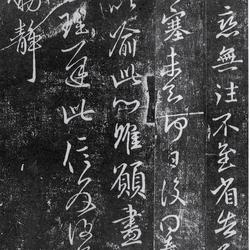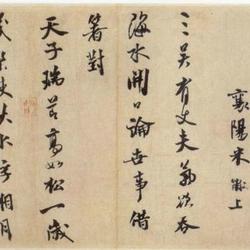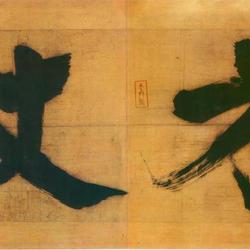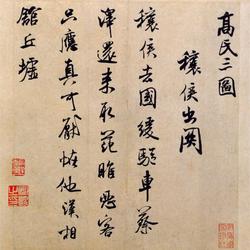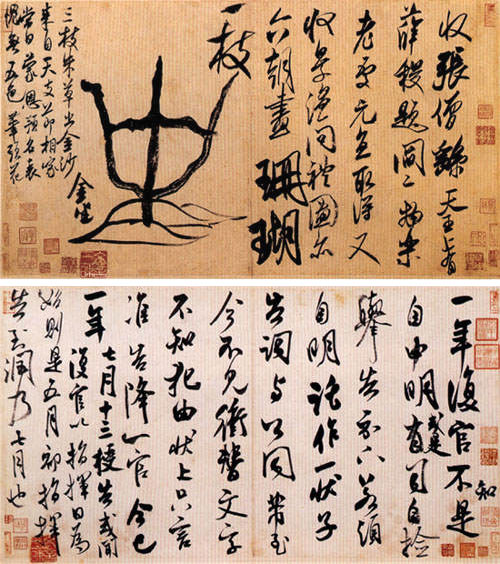
The writing material of "Coral Tie" is very special, bamboo paper, light yellow, with more bamboo fibers on the paper. It is said that this is the earliest work written on bamboo paper found so far. The explanatory text of this post is: "Collect Zhang Sengyao Tianwang, with an inscription by Xue Ji. Yan Erwu, Le Lao Chu Yuanzhi obtained it. Also received Jing Wen's picture of asking for gifts, also painted in the Six Dynasties. A branch of coral (a coral pen stand beside it) The two characters "Golden Sitting" in the book). The three branches of red grass growing out of the golden sand are from the family of Tianzhi Jiexiang. On that day, I was blessed to be named, and I am ashamed to have five-color pen-headed flowers."
"Coral Tie" is a famous ink written by Mi Fu in his later years. Compared with the works before his middle age, the writing style of this work is more bizarre and advanced, written casually, with natural charm, more high-spirited spirit, and more interesting sense of form. Mi Fu's pen is bold and steady, and his characters are broad and clear. His calligraphy style is unrestrained and unrestrained, and it is also in line with the law. The predecessors have already made conclusions about Mi Fu's "Coral Tie": Yu Ji of the Yuan Dynasty commented on its "high-spirited spirit and strong muscles", and Shi Guangyuan called it "an unforgettable masterpiece in Mi's book and the best Tie in the world". "History of the Song Dynasty·Biography of Wenyuan" says: "Fu is particularly wonderful in calligraphy and ink, with calm and flying strokes, which captures Wang Xian's brushstrokes." Mi Fu is famous for his calligraphy. He has a profound understanding of the brushwork, composition and charm of famous artists of the previous generation. It is precisely because he imitated the ancients so much that he was ridiculed as "Ji Zi". In this regard, Mi Fu once said: "I was unable to establish a family in my prime. People say that my book is a collection of ancient characters. I am good at taking advantage of all the advantages and summing it up. Since I started a family at an old age, people see it and don't know who to call it their ancestor." Yea." He deeply understood that to have a successful family, learning tradition is essential. The so-called "collection of characters" shows to a certain extent that Mi Fu has made great efforts in tradition. Mi Fu's achievements come entirely from his hard work: when he was young, he studied Yan, Liu, Ou, Chu and other Tang Kai scripts, and went to the pond every day to lay down solid basic skills. Mi Fu was also very conscientious in writing. He said: "I wrote "Hai Dai Poems" three or four times, and every time I wrote one or two good words." I wrote a poem three or four times, but I was satisfied with only one or two words. The joys and sorrows involved in this process cannot be understood except by an expert, which shows the rigor of his creative attitude. When Su Dongpo was demoted to Huangzhou, Mi Fu went to visit him for advice. Su Dongpo advised him to learn from the Jin people. Beginning in 1082 (the fifth year of Yuanfeng), Mi Fu devoted himself to the Wei and Jin Dynasties, taking the calligraphy style of the Jin people as his guide, and searched for many Jin people's Dharma texts. Even his study was named "Baojin Zhai". Su Dongpo had a high opinion of Mi Fu. He once said, "Hai Yue has been writing in seal script, official script, Zhen script, Xing script and cursive script all his life. He is calm and cheerful, and he should be at the same level as Zhong and Wang." Mi Fu's calligraphy has far-reaching influence, especially in calligraphy. In the late Ming Dynasty, there were many scholars, such as Wen Zhengming, Zhu Yunming, Chen Chun, Xu Wei, Wang Juesi, and Fu Shan, who all drew nourishment from the rice character. This influence continues to this day. Mi Fu is well aware of the relationship between "incoming posts and outgoing posts" - learn from the ancients, but you don't have to be self-reliant and adhere to the ancients' every detail. The most important thing in art is innovation. Mi Fu calls himself a "brush character". Although this is a self-effacing statement, it also hits the essential point. "Brush calligraphy" summarizes his characteristics of using the pen quickly and vigorously, and doing his best with all his heart and soul. His calligraphy works, ranging from poems and calligraphy to small rulers, tablets, inscriptions and postscripts, are all characterized by joyful, dynamic, dynamic, and fresh. Judging from the existing handwriting of Mi Fu, the word "brush" vividly expresses the spirit of the word "rice". Mi Fu had never been involved in political turmoil in his life, and his life was relatively stable, so he had more time to browse the collection of books in the imperial palace. In addition to calligraphy, Mi Fu is good at ink landscape painting. His landscape paintings are called "Mijia Yunshan", but few of Mi Fu's paintings have survived. The only "Coral Pen Stand" that can be seen so far can hardly be said to be a "Mi Painting" in the true sense.

